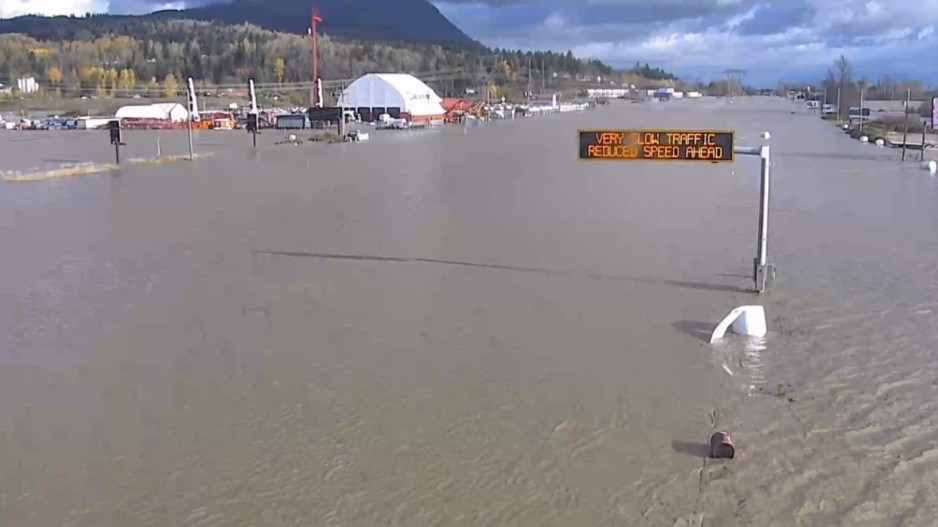The sun came out today, following a three-day deluge that broke rainfall records and washed out and closed highways throughout B.C., triggered landslides that derailed trains, caused power outages, ran a barge aground in English Bay, and necessitated the evacuation of the entire town of Merritt.
Parts of Abbotsford and Chilliwack also remain under an evacuation notice. Schools have been closed in Abbotsford, Chilliwack, Mission and other parts of the Fraser Valley and Lower Mainland.
The Lower Mainland remains cut off from the rest of B.C., as sections of major highways, including sections of the TransCanada Highway in Abbotsford, and Highway 99 south of Lillooet, were closed due to washouts and landslides.
The Trans Mountain pipeline, which supplies both oil and refined fuels to the Lower Mainland, is shut down and work on its expansion has been suspended.
"The pipeline remains shut down due to widespread flooding and debris flows in British Columbia and Washington state," the company said in a statement to BIV News. "In order to restart the pipeline, we need to complete an assessment of the system in affected areas and are undertaking that work by air and on the ground.
"Construction on the Trans Mountain Expansion Project remains stood down in the Fraser Valley, Coquihalla, and Interior regions of BC affected by the weather event. Inspections of these worksites and equipment are underway, and construction will restart when it is safe and practical to do so."
Dozens of highways and roads in B.C. are still closed in some sections. The Malahat Highway on Vancouver Island was closed, but has re-opened to single-lane traffic only, and long delays are to be expected.
Rail lines have also been cut off, which will lead to even more supply chain problems -- something exacerbated first by the pandemic and then, this summer, by wildfires.
All trains coming to and from the Port of Vancouver have been halted due to flooding in the B.C. interior, according to the Port of Vancouver. Both CN and CP Rail have said that no rail traffic is currently able to move between Kamloops and Vancouver.
The Ministry of Transportation will hold a press briefing later today to provide an update on highway closures and re-openings. DriveBC advises against any travel to Abbotsford and surrounding areas.
More than 200,000 British Columbians lost power, and many outages continue, due to both flooding and high winds. The town of Hope was without power Sunday and Monday, according to BC Hydro.
In Merritt, mobile homes located near the river were washed away, and the rest of the town's 7,500 residents had to be evacuated as a result of having too much water, but none to drink.
The town's wastewater treatment plant had to be abandoned, leaving the town without a functioning sewage system, and then a power failure on pumps left the town without drinking water, much of which comes from wells, which became contaminated, said Greg Lowis, emergency operations centre information officer for Merritt.
Most of the town's 7,500 residents remain evacuated and it may be a week or more before they can return home.
"At the moment, you can't get (drinking) water in Merritt, and if you do get it, you can't dispose of it," Lowis said.
The economic costs of the flooding are not yet known, but are sure to run into the hundreds of millions if not billions.
"The magnitude of the damage is unbelievable," said Bridgitte Anderson, president of the Greater Vancouver Board of Trade (GVBOT). "It's going to take weeks, even months, for us to really fully understand the impact of the damage this has caused to our economy."
She said $500 milllion worth of goods moves through the Port of Vancouver every day, and is now suffering yet another interuption in the flow of goods by truck and rail. On top of the pandemic, which caused severe supply chain disruptions, wildfires this summer also halted the flow of goods by rail.
"The port has already been working overtime in the past many months to make up for the impact of the pandemic on global supply, so this will be a further blow for the port, as we're all trying to handle the supply chain shortages that we've seen," Anderson said.
"We have supply chain issues already that have been impacting us because of the pandemic, and now we can't goods...down to the Lower Mainland. The scope of this is really remarkable."
The Town of Merritt remains evacuated, as the town's sewer and drainage system has suffered a total failure. A city official says citizens in Merritt may have to remain evacuated for a least a week.
Katerina Anastasiadis, CEO of the Abbotsford Chamber of Commerce, said the Trans Canada Highway from Whatcom Road to No. 3 in Abbotsford remains cut off, as is No. 7 Highway, which connects Mission to Abbotsford.
“It also reaches up to Maple Ridge,” Anastasiadis said. “So Maple Ridge, Mission, Abbotsford connections are cut off due to flooding.”
She is just beginning to hear reports of damage to businesses in the area. The Clarion Hotel in Abbotsford has cancelled all events this week, she said, as much of the town is under water and under evacuation notice.
The flooding has underscored what Anastasiadis said has been flagged by the city as a potential problem: the need for better dyking systems, particularly to address flooding problems in the region known as Sumas Prairie. Sumas Prairie is actually a former lake that was drained. Flooding has practically returned it to a lake.
“This is something the city actually has been aware is a big risk for us, with our dyking systems and something we worked with the federal government on to get infrastructure money for,” Anastasiadis said. “I’m hoping, with this incident, that they can see this is definitely a pressing issue for us. We need to be able to have reliable sources of funding to build this kind of critical infrastructure.”




